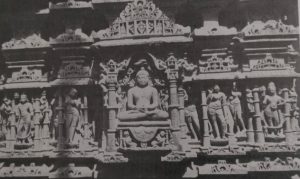Osian
 The Mahavira temple of Osian (also Osia or Osyan), located on the western edge of the town and a long way from the Hindu temple-hill, has found entry into about all the mayor books on Indian art and architecture. The same cannot be said, regrettably. of other, equally splendid Jaina temples.
The Mahavira temple of Osian (also Osia or Osyan), located on the western edge of the town and a long way from the Hindu temple-hill, has found entry into about all the mayor books on Indian art and architecture. The same cannot be said, regrettably. of other, equally splendid Jaina temples.
The easy access from Jodhpur by rail and road – a distance of fifty-two kilometres may have something to do with it. The main reason for the scholars’ attention to this shrine is, however, its significance as one of the very few still extant prototypes of a new and more elaborate temple- that was to develop into such masterpieces as the Parshvanatha temples at Khajuraho, Sadri and Ranakpur.
The Mahavira temple at Osian was built, according to an inscription, in the last quarter of the eighth century, at a time prior to the bigger intrusions of Muslim forces, in the course of which many temples were reduced to rubble. Unfortunately, none of the original Jina statues of the Mahavira temple have come to light; also the tower above the sanctum is of a later time and style; the date given for this addition or restoration is 1016.
Though there are only a few Jaina families left in Osian, this well documented temple is still in active Shvetambara worship. “The Osian Mahavira temple,” writes J.C. Harle on page 144 of his already cited book on Indian art, “is a thriving place. of worship in contrast to the abandoned and sometimes misused temples just considered.” A school. open to children of all religions, has been established and given shelter in a house built next to  the temple.
the temple.
Mahavira Temple, detail of temple fa- çade. Eighth century, last quarter. Note the natural postures of the human figures.
Osian, part view of the Mahavira Mandir with the Hindu Temple-Hill in the background.
Student pujaris, Hindus by faith, practise for a religious ceremony scheduled for the following day in the famous Osian Mahavira Temple.
